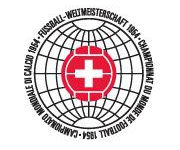Tournament Overview

The group format had returned to the finals in 1950 – replacing the straight knockout method that had been employed in 1938 – but in 1954 there had been a slight and somewhat bizarre adaptation that saw each group consist of two seeded and two unseeded teams, with each seeded team playing the two unseeded ones opposed to a simple round-robin. Just as curious was the rule stipulating that if a group game finished as a draw after ninety minutes, extra time would be played – with a draw being the result if the sides were still level after the additional half an hour. Two points were awarded for a win and one for a draw, and two teams would qualify from each group for the quarter-finals – with a playoff being the tie-breaker if two teams finished on the same number of points.
The 1954 tournament saw a total of twenty-six matches including playoff games, and a record of 140 goals at 5.38 goals per match. Twenty-two of these goals were scored by Sepp Herberger’s German side, who in one of the biggest shocks in World Cup history upset the red-hot favourites Hungary in what became known as Das Wunder von Bern – “the miracle of Berne”.
Qualifying Campaign and pre-tournament build-up
Having been excluded from first postwar tournament in Brazil in 1950, Germany returned to the international fold in time for the 1954 World Cup qualifying campaign – with the finals being held in neighbouring Switzerland. Sepp Herberger had fought tooth and nail to maintain contact with his players and keep the spirit of the German national team alive during even the darkest days of the Second World War – and his loyalty was rewarded when he was reappointed to the post of Nationaltrainer in 1950.
The Nationalmannschaft’s first World Cup qualifying campaign since the the late 1930s saw them placed in a group of three teams alongside Norway and the Saarland – coached at the time by a certain Helmut Schön. Despite dropping a point in their first qualifying fixture against Norway in Oslo, Herberger’s side easily finished top of the group, dropping just a single point in their four matches.
Germany’s Tournament in brief
With the red-hot favourites Hungary expected to walk away with the trophy, the unseeded German team headed for Switzerland simply to play to the best of their ability and make a decent impression on the watching world. Having comfortably beaten Turkey in their opening match, they were overrun 8-3 by a rampant Hungarian side before facing up against the Turks for a second time in a playoff which they won 7-2.
Herberger’s side seemed to be getting better with each game, as a 2-0 defeat of Yugoslavia in the quarter-finals put them in the last four against Austria, who found themselves on the end of a 6-1 hammering as the Mannschaft shifted through the gears.
The final saw a second encounter with the Hungarians, who seemed to have picked up where they had left off in the first phase by scoring two early goals. Nobody could ever have expected any team to come back from that, particularly a side that had been beaten by five clear goals less than three weeks before – the rest, as they say, is history.
Germany’s astonishing victory – the first and last by a wholly amateur side – may not have actually changed anything directly, but it served as a catalyst for the peoples’ psychological renewal after what had been almost two decades of war and economic stagnation. It coincided with what had become known as the Wirtschaftswunder – the economic miracle – and the return of many of those who had been prisoners of war in the Soviet Union, but perhaps more crucially the wave of euphoria generated by the success of Herberger’s squad constituted a major psychological step forward in forging a new and positive postwar identity.
Germany Tournament Squad List »
Germany Tournament Results and Overview »

Actually I think Turkey were a seeded team because they eliminated Spain in the qualifiers by toss of a coin after the replay in Rome had ended in draw. In reality Spain should have been in Germany’s group as a seeded team.
Sounds logical! Come to think of it I don’t know why I made my initial assumption that Germany were one of the seeded teams – they had only just started to play again after being isolated for so long.
“in 1954 there had been a slight and somewhat bizarre adaptation that saw each group consist of two seeded and two unseeded teams, with each team playing one seeded team and one unseeded one as opposed to a simple round-robin. ”
Are you sure? I always thought that the seeded teams didn’t meet each other but played both unseeded teams meaning that the unseeded teams of course only met the seeded teams of their group.
Thanks Harry, I stand corrected!
In trying to work out this system I worked from the assumption that West Germany were one of the seeded teams – when in fact Turkey were. This being the case, what you say makes perfect sense.